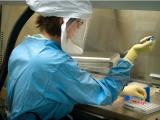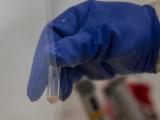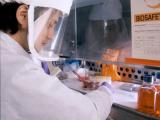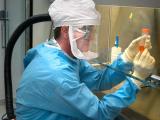Mar 17, 2003 (CIDRAP News) People whose hands may be contaminated by anthrax should wash them with either antimicrobial or conventional soap and water, but should not try to cleanse them with an alcohol-based hand rub, a new study suggests.
Washing with either regular or antimicrobial soap and water substantially reduced the number of anthrax-like bacterial spores on participants' hands, whereas using an alcohol-based handrub had no effect, according to the report in the Journal of the American Medical Association. Using a special chlorine-containing towel also reduced spore contamination, but that method took longer to produce the same results as washing.
"Our data suggest that current recommendations for decontamination of exposed person with soap and water . . . [are] likely adequate," states the report by David J. Weber, MD, MPH, and colleagues from the University of North Carolina, Chapel Hill. They write that "alcohol is not sporocidal and should not be used either for hand hygiene or environmental decontamination" if anthrax may be present.
The investigators used Bacillus atrophaeus as a stand-in for Bacillus anthracis because the two are closely related and because B atraophaeus appears to be slightly more resistant to germicides than B anthracis is.
Using a nonantimicrobial soap as the control, the authors tested three antiseptics: a 2% chlorhexidine gluconate solution, a waterless rub containing 61% ethyl alcohol, and an antibacterial microfiber towel. The towel contained chlorine and was moistened just before each use. Six participants tested each product, with two participants applying the product for each of three time intervals10, 30, or 60 seconds. In each trial, the participant applied the product three times, using the same interval each time.
Before washing, the subjects' hands were exposed to a solution containing a high concentration of B atrophaeus spores. The quantity of spores on the subjects' hands was measured at baseline and after each washing. For the measurement, participants put their hands into large gloves containing a sampling and neutralizaing solution, and a sample of this solution was subsequently analyzed.
Handwashing with nonantimicrobial soap and water appeared to be the most effective decontamination method for the time invested. This method yielded the following log reductions (and 95% confidence intervals) in colony-forming units per milliliter for the three time intervals: 10 seconds, 2.4 (2.2 to 2.5); 30 seconds, 2.3 (2.2 to 2.4); and 2.1 (1.9 to 2.4).
Log reductions in spore counts with the chlorhexidine gluconate solution were 2.1 (2.0 to 2.3) at 10 seconds, 1.8 (1.5 to 2.0) at 30 seconds, and 1.7 (1.5 to 1.9) at 60 seconds. Increasing the wash time from 10 to 60 seconds yielded no advantage with either the regular soap and water or the chlorhexidine gluconate.
By contrast, the effectiveness of the chlorine-containing towel increased with time. The log reductions were as follows: 1.3 (1.1 to 1.5) at 10 seconds, 1.6 (1.2 to 2.0) at 30 seconds, and 2.2 (2.1 to 2.2) at 60 seconds. At 60 seconds, the towels were significantly more effective than chlorhexidine and about the same as soap and water. The alcohol product did not significantly reduce spore counts at any of the time intervals.
Since chlorhexidine gluconate "did not provide improved elimination of spores compared with soap and water," the current federal recommendation for decontamination with soap and water is probably sufficient, the authors conclude. "Our study did not allow us to distinguish between physical removal and bacterial inactivation," they note. They call the study the first direct evidence to support the current recommendation on decontamination for people exposed to anthrax.
Weber DJ, Sickbert-Bennett E, Gergen MF, et al. Efficacy of selected hand hygiene agents used to remove Bacillus atrophaeus (a surrogate of Bacillus anthracis) from contaminated hands. JAMA 2003;289(10):1274-7 [Abstract] [Full text]



















